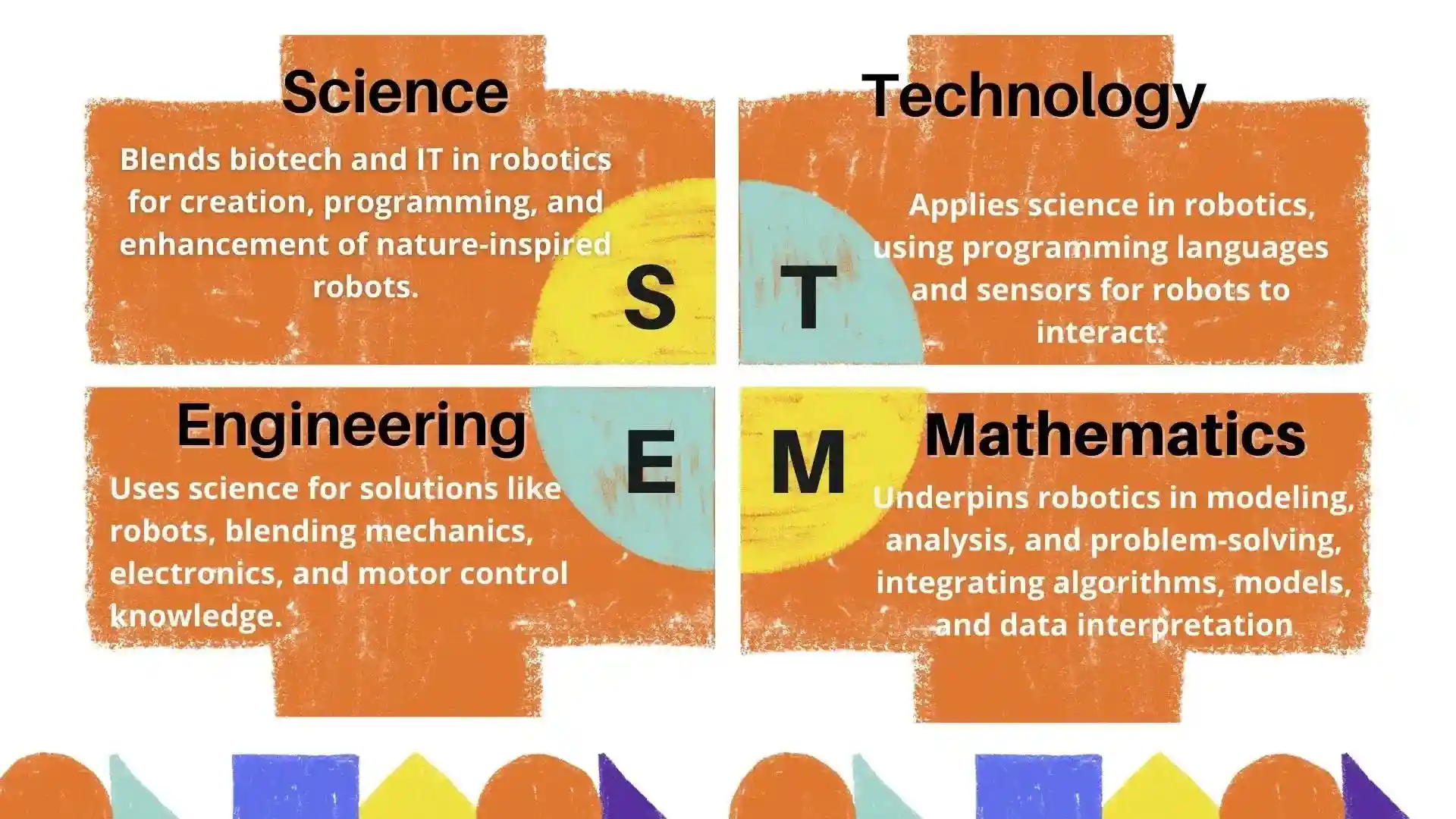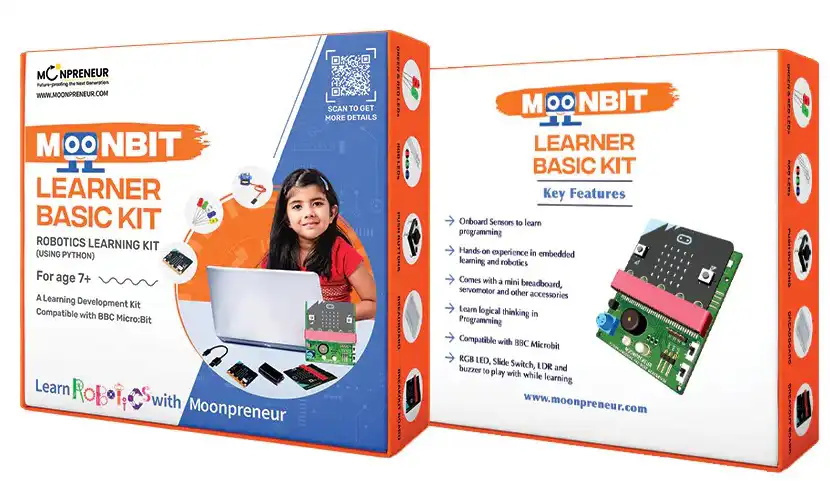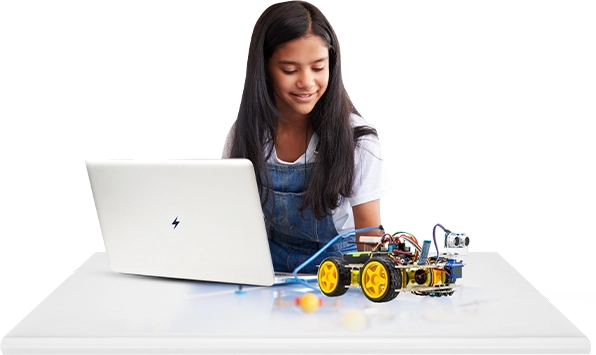Moonpreneur
Is your child fascinated by robots and dreams of creating their robots? Engaging in robotics education offers a promising future, as the industry is projected to provide opportunities, as indicated by a report.
The market research report indicates that the global educational robot market was worth $1.2 billion in 2021 and is projected to expand at a compound annual growth rate (CAGR) of 16.27% to reach $3.0 billion by 2027.

How to get started in robotics started in robotics might seem daunting, especially for kids, but it’s an enriching journey that combines creativity, engineering, and problem-solving skills.
Now, how and where can your child begin learning robotics?
This beginner’s guide covers everything that your child needs to know about how to get started in robotics and explore this exciting field from scratch.
Let’s embark on this robotics learning together!
Step 1: Spark Your Child’s Interest
a. Start with the Basics
The only way you can stay on top is to remember to touch bottom and get back to basics.
Shane Black
It’s important to understand the basics of robotics, which combines elements of computer science, engineering, and mathematics, which is also known as STEM. STEM stands for the following:
i. Science gives robotics the basics for making, programming, and improving robots, mixing fields like biotech for nature-inspired robots and IT to manage data for complex tasks of making robots work.
ii. Technology plays a vital role in robotics, by applying scientific knowledge for practical uses. For a deeper understanding of robotics, knowledge in areas such as programming (with languages like Python, Java, and C++) and sensors (which help robots sense their surroundings) are essential.

iii. Engineering is about applying scientific principles to design and create solutions, including robots. In robotics, understanding mechanics helps in constructing robots that move effectively, while knowledge of electronics is crucial for their wiring and programming, and familiarity with motors is key to controlling their movement.
iv. Mathematics is crucial in robotics for modeling, analyzing, and solving problems. Key areas include computational mathematics, which helps in creating algorithms and models for robots, and data science, which uses math to analyze and interpret data, essential for making robots smarter and more adaptable.
b. Read and Research
Reading and researching are essential for gaining knowledge, sparking innovation, and staying informed about developments in any field. Introduce your child to the world of robotics by encouraging them to read books and articles as well as take robotics courses online.
Look for robotics for kids online classes. These classes are designed skillfully to simplify complex robotics concepts, avoiding technical jargon for a smoother learning experience.
You can choose one or all of the following options for your child to read and learn:
i. Robotics Books: There are several books on robotics available based on age and some popular examples include “The Wild Robot” by Peter Brown and “Awesome Robotics Projects for Kids” by Bob Katovich.
ii. Blogs: There are several blogs written by subject matter experts that provide kids with accessible, up-to-date insights into robotics, sparking curiosity and enhancing their understanding of the field. Some popular blogs are :
- Robotics and Coding- A Complete Guide For Kids by Moonpreneur
- Make a robot: A fun and educational journey into robotics for kids by Raspberry Pi.
- Robotics For Kids: Quick Guide For Kids to Start Learning by Jetlearn
iii. Storybooks: Storybooks are a great way to introduce kids to robotics. These visually attractive books blend educational content with visualizations and entertainment to pique interest and facilitate learning in a visually attractive manner.
For example Treasure Hunt storybook. It follows the adventures of a young boy named Adam, who goes on a treasure hunt with his friends. The tale of “Magical Grove” takes your child into a fascinating and magical world while teaching them the fundamentals of robotics.

iv. Online Video Content: If a picture is worth a thousand words, what is a video worth? Writer Scott MacFarland posed this question in his 2014 Huffington Post article, suggesting that we are in the midst of a paradigm shift. He wrote that if “a picture is worth a thousand words, then maybe a moving picture (video) is worth a million people.”
Undoubtedly, videos are a great way to teach kids.
Some online videos that can enhance your child’s knowledge of robotics are:
- Basic of Robotics Explained To A Child by Moonpreneur
- An Introduction To Robotics 🤖 by Teach Kids Robotics
- Kids first coding & robotics by Thames & Kosmos
Step 2: Engage with Hands-On Projects
a. DIY Robotics Kits
When kids engage in hands-on projects and experiments, they learn the nuances of the subject, which enhances their abilities in problem-solving, creativity, critical thinking, and self-expression, encouraging them to generate new ideas.
One of the best ways to get started is through DIY robotics kits for kids. These are beginner robotics kit and come with all the necessary parts and instructions to help your child build their first robot. Some popular options include:
i. Moonbit Learner Basic Kit: The Moonbit Learner Basic Board empowers kids to learn Robotics and Python Programming, fostering innovation and creativity under Moonpreneur’s guidance. Price starts from $35.

ii. LEGO Mindstorms: LEGO play starts to release a child’s potential from the moment they pick up their first brick. It inspires and develops the Builders of Tomorrow. Price starts from $1073.
iii. Makeblock: They strive to deliver STEAM education solutions that foster a growth mindset in the next generation of problem solvers by developing essential skills for kids. Price starts from $79.
iv. VEX Robotics: Including science and engineering principles, VEX encourages creativity, teamwork, leadership, and problem-solving among children. It inspires kids of all ages to become STEM problem solvers of tomorrow! Price starts from $456.
b. Create Simple Projects
Another way to how to get started in robotics is by creating a simple robotics project. These projects don’t require advanced knowledge or expertise and exclude complexity.
Quick Tip!
Kids should document their ideas, processes, and learning points. A journal is invaluable for tracking progress, reflecting on what they've learned, and planning future projects.
These projects will help your child understand the basics of mechanical design and control systems. Some simple projects to get started with include:
i. Building a line-following robot: The line-follower robot is an automated machine that moves along a line drawn on the ground. In this activity, sensors are used to build a robot to follow a line on the ground.
ii. Creating a remote-controlled robot: Controlling something with a remote is one of the simplest robotics projects. This involves building a robot that can be controlled using a remote control.
iii. Designing a simple robot arm: A robot arm is a type of robot consisting of parts linked together in the same way as those of a human arm, mounted on a stand. Another activity your child can try is building a robot arm at home that can move objects.
Robotics arm might have reminded you of Doctor Octopus from the movie Spider-Man: No Way Home and his dialogue-
The power of the sun in the palm of my hand. 😉
Step 3: Learn to Code
A robot is nothing without a code. To make it functional, one must need to know how to program it. Coding is an essential skill that allows kids to create a set of instructions for their robot to read and execute.
Einstein has said that “Curiosity is a delicate little plant which, aside from stimulation, stands mainly in need of freedom”. So, kids should stay curious and keep learning as robotics is a vast field and ever-evolving. They should learn new things, whether it’s a programming language, technology, or a concept in robotics.
As a parent, you might wonder which programming language your child should learn to get started in robotics. There are several kid-friendly programming languages and platforms that can introduce your child to the world of coding through interactive and engaging methods, such as:
i. Python: Python equips kids with essential programming skills for robotics. For example, if your child builds a robot buggy, they can use simple Python commands to make it move around.
ii. Scratch: Scratch is a visual programming language. It introduces children to programming through interactive, drag-and-drop blocks that make creating animations, games, and stories easy and fun. For example, creating a robotics project in scratch that controls a robot buggy.
iii. Blockly: Blockly introduces kids to programming concepts through visual blocks, making it easier to understand and apply robotics principles creatively. One popular example of the Blockly project is the Magnetic Train, which teaches kids how to program a virtual train using magnetic levitation principles, blending physics with coding in an interactive way.
iv. Javascript: JavaScript can be used to control hordes of small robots, creative maker projects, and IoT devices. A good example of a JavaScript robotics project is Spaceship Lander where a spaceship is shifted right and left using JS keyboard events.
v. 3D design: Learning 3D design lays the foundation for robotics by enabling precise modeling and prototyping skills.
Step 4: Join a Robotics Club or Community
Joining a robotics club or community is a fun extracurricular activity where kids can dive deeper into robotics alongside peers with similar interests. There is also an option of joining global robotics community like IEEE – Robotics & Automation Society. World’s top roboticists are members of this robotics community.
These clubs, often found in schools or community centers, offer a great chance to learn more, share ideas, and collaborate on projects. You can also look for clubs online through forums and social media groups focused on robotics.
Quick Tip!
Searching for "robotics clubs near me" can help you find one easily in your neighborhood!
Some options for your kids to socialize and learn are:
i. Social media groups: They are online communities where students interested in robotics can share ideas, ask questions, and learn from each other.
ii. Online Forum: An online forum for robotics is a website where students can discuss, share advice, and ask questions about robotics.
iii. Community center:It is nothing but a local place where kids can meet, learn, and work on robotics projects together.
iv. Local club in school: A local club in school for robotics is a group where kids can join to explore and together create robotics projects.
Never Give Up!
Step 5: Experiment and Innovate
As children gain experience and knowledge, the next obvious step is experimenting and innovating. It helps your child to develop new skills, learn from their mistakes, and create unique projects. This involves taking risks, trying new things, and pushing the boundaries of what they know.

Some ways to experiment and innovate in robotics include:
i. Combining different technologies: Combine technologies, such as sensors and artificial intelligence. It can help to create robots that can perform more complex tasks.
ii. Solving real-world problems: Using robotics to solve real-world problems, such as cleaning up pollution or aiding in disaster relief efforts, can develop innovative solutions to critical issues.
iii. Team Work: It involves working together with others to build and program robots, sharing ideas, and solving problems as a group. Such activities inculcate teamwork and trains kids for a brighter future.
iv. Leadership: Working on robotics projects helps kids develop leadership skills through teamwork, problem-solving, and coordinating roles to achieve common goals.
Step 6: Participate in Competitions
Last but not least is a robotics competition that is not only fun but also provides a platform for children to showcase their skills and learn from others. Some of the popular competitions where your child can enroll are:
i. MoonBattle Conference 2024: The MoonBattle Conference 2024, is a significant event highlighting the key aspects of STEM, eLearning, addressing educational gaps, robotics, the role of entrepreneurial and problem-solving skills, and parental involvement embracing innovative methods of learning and teaching.
If you are a parent, student, or young entrepreneur, mark your attendance for the event happening on 21st April, 2024.
ii. FIRST LEGO League: FIRST LEGO League guides youth through STEM learning and exploration at an early age. From Discover, to Explore, and then to Challenge, students will understand the basics of STEM and apply their skills in an exciting competition while building habits of learning, confidence, and teamwork skills along the way.
iii. VEX Robotics Competition: VEX competitions foster experimental skills and capitalize on the motivational effects of competitions and robotics to help all students create an identity as a STEM learner.
iv. BEST Robotics Competition: “BEST” stands for Boosting Robotics Engineering, Science & Technology. It’s a robotics tournament in which teams compete against each other. Every year, they choose a new challenge based on current events.
Conclusion
Getting started in robotics from scratch might seem like a challenging task, but with the right resources and approach, it’s possible, even for kids. By following these steps, you will ensure the right path for your child on how to get started in robotics. Remember, the key is to start simple, keep learning, and most importantly, have fun along the way.
Moonpreneur is dedicated to preparing your child for success in college and the evolving world of AI. To kickstart your child’s journey in robotics, sign up for a free 60-minute workshop today!
What are your thoughts on this? Is your child learning robotics and how did they start with robotics? Share in the comments!
Update: This article was last updated on 21st Feb 2024 to reflect the accuracy and up-to-date information on the page.
















Good read! I am encouraged to get my son into robotics but want to know how to start a career in robotics?
Hi Patrice, to start a career in robotics for your son, focus on STEM education, engage with robotics kits and projects, motivate him to learn programming languages like Python and C++, pursue internships, and network with professionals. Staying updated and specializing in areas like AI will be crucial.
I am already building robots and want to know how to get a degree in robotics?
Hi Eliza, Bachelor of Science in Robotics Engineering, a four-year curriculum, is the most popular robotics degree. Many paths exist beyond just traditional degrees, with global schools offering specialized robotics programs some of them are BIT Intelligent Robotics Institute, CMU Robotics Institute and (EPFL)’s School of Engineering.
For more details please read: IS THERE A DEGREE IN ROBOTICS?